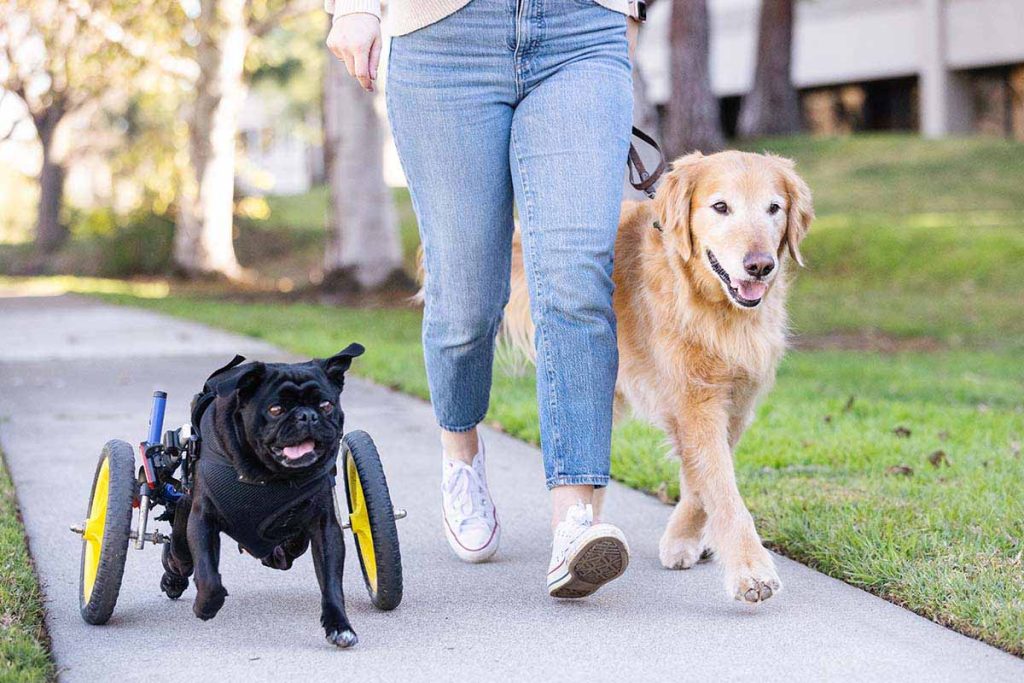Benefits of Walking Your Dog
Getting some fresh air is essential for overall health. Let’s take a look at the benefits of walking your dog can not only improve your dog's health, but yours too!
Many loving pet parents take their dogs on daily walks as part of a regular exercise routine for both themselves and their furry friends. As it turns out, it’s essential for your dog’s well-being, and physical activity is good for you, too!
But just what are the benefits of walking your best friend every day? Let’s take a look at just how getting enough exercise and some fresh air can be helpful for your pooch.
What are the Benefits of Dog Walking?
Dogs need mental and physical stimulation, and a walk is a great way to get both in. A daily routine that includes walking the dog is good for both you and your dog. Let’s break down how it helps improve wellness for you both.
Benefits of Walking Your Dog

Spending time with your best friend is always a good thing for your health and his, but here are some ways that it really helps your pooch.
Weight Management: Just as in humans, obesity is a big problem for pets in the United States. In fact, according to the Association for Pet Obesity Prevention’s 2022 report, some 59% of dogs and 61% of cats in the U.S. are overweight or obese.
And, just as in humans, the solution to the problem is regular exercise combined with eating healthy foods in moderate amounts. Regular walks are part of a healthy routine for weight management.
Joint Health: Osteoarthritis is the common type of arthritis that comes with getting older. This is also true for your pets. Immobility associated with osteoarthritis is a relatively common health problem in the older dog.
If your dog is sedentary for too long, his joints can become stiff and more painful. Keeping those joints in motion with regular walking can help ease the pain associated with osteoarthritis.
Regulates Blood Sugar Levels: Regularly walking your dog helps regulate his blood sugar levels and reduce insulin resistance. The physical activity health benefits from regular walking include the fact that a long walk will help increase your dog’s insulin sensitivity, which means that his body will be able to more effectively regulate blood sugar levels.
Digestive Health: Several studies demonstrate that regular walking helps regulate the digestive tract. It modifies the microbiome of the gut by increasing the number of beneficial bacteria. Studies show also encourages motion in the stomach and intestines, which helps to regulate bowel movements.
Urinary Health: Given that your furry friend will likely relieve himself several times during even a short walk, a daily walking routine helps promote urinary health. If urine sits in the bladder for a lengthy period of time, an infection is more likely to occur. Regularly emptying the bladder helps prevent uncomfortable and potentially dangerous infections from starting.
Mental Stimulation: Your dog gets a chance to explore the world and see some new sights on his daily walk. This greatly improves his mental health. He can sniff around to see who’s been in the neighborhood, and he may also be able to interact with other dogs or people. All of that provides him with mental stimulation, plus he gets to spend time with you, which strengthens your bond.
Reduces Undesirable Behaviors: Dogs naturally engage in certain behaviors that we humans tend to think of as destructive behavior. This includes hunting, scavenging, and exploring, which can be expressed as chewing, jumping up on people, and roaming.
Regular walking gives your dog a chance to engage in those behaviors without being destructive. It also helps release pent-up energy and tires your best buddy out, both mentally and physically. That equates to a better-behaved dog. Additionally, it reduces certain negative attention-seeking behaviors since he’s getting to spend time with you, and that’s great for his emotional health.
Helps with Socialization: Getting your dog out of the house and exposing him to other people and animals on daily walks helps to socialize your dog. He learns the appropriate way to interact with other people or animals, which also makes a better-behaved dog. It’s the easiest way to ensure your dog is a good neighbor.
Benefits of Dog Walking for You

Dog walking is not just for the dogs! Dog walkers — that’s you — also benefit from daily walks with their best friends. Here are just a few of the benefits:
Health Benefits
As with your dog, regular walks can help you to prevent obesity. According to the experts, approximately two out of three adults in the U.S. are overweight or obese. Walking your dog regularly can help you drop the weight. In fact, one study found that dog walkers were less likely to be obese than their non-dog-owning neighbors.
In addition to helping you drop some extra pounds, research shows that regular walking helps reduce the risk of cardiovascular disease. It can also help reduce the risk of certain cancers and type-2 diabetes.
Emotional and Psychological Benefits
Dog walking not only creates physical health benefits for pet parents and their pooches, it also conveys significant emotional and psychological benefits for dog owners. In one study, dog owners reported feeling happy when their dog was enjoying the walk. They also experienced more social interactions on dog walks.
In other studies, dog walkers were seen as friendlier and more approachable than people without dogs. They had improved self-esteem, and they even experienced less stress at the dentist! Additionally, just stroking and petting a dog can decrease your stress levels and lower your blood pressure.
How Much Should You Walk Your Dog?

How much you should walk your dog depends on his age, size, and health condition. It’s always a good idea to consult with your veterinarian before beginning an exercise routine. That being said, there are some general guidelines you can use to get started.
Puppies
Puppies have less endurance than adult dogs, and they need a potty break every two to four hours. That means they won’t be able to go for a very long walk, but on the other hand, they will need to go out more often.
It’s also important to make sure your puppy is comfortable walking on a leash before you go out into the ‘real world.’
To get started with a puppy, a good guideline is to go for a 10-minute walk two or three times a day. Stick with short, frequent walks, and don’t push your pup too far too fast. It’s also important to realize that what is considered a long walk will be different for a teacup poodle than it will for a lab pup.
Adult Dogs
For adult dogs, how long you should walk depends on their general fitness level. If your dog is out of shape or not too active, a 10 – 15 minute walk is a good place to start. If your dog is otherwise healthy, gradually increase the length of their walks or start taking them out more frequently.
Senior Dogs
Exercise is an important part of keeping a senior dog healthy. Moreover, daily walks help keep them mentally fit. Of course, senior dogs may have more health challenges that may require more breaks when walking or shorter walks.
Depending on their health concerns, you might even consider taking a wagon or stroller along in case they need a ride. Always consult with your veterinarian before starting an exercise program. They can also advise you on how to proceed with your dog.
Walking as Part of a Comprehensive Wellness Plan
Walking your dog is a healthy part of your lifestyle for both you and your pet. You can do wonders for yourself and your pooch just by going for even a short walk. What’s more, a nice walk can and should be fun for both you and your dog. When you combine daily walks with a healthy diet and regular visits to the veterinarian, you’ll be doing your part to ensure you’ll have a long, happy, and healthy life with your best buddy.
This content is for informational use only and does not replace professional nutrition and/or medical advice, diagnosis, or treatment. It is not a substitute for and should not be relied upon for specific nutrition and/or medical recommendations. Please talk with your veterinarian about any questions or concerns.







